|
In September of 2008 we decided to return to the area of the huge pocket found in July of 2005 (MMP11-05). In August of 2005, after pocket 11-05 had completely exhausted us, we decided to explore the area to the east and south of the space. As we did so we encountered an area of extensive mineralization. This was expressed in the form of massive lepidolite and large spodumenes. This area was vuggy but there was no more pocket...or so it seemed at the
time. What
was most puzzling was the pegmatite seemed to stop abruptly as we worked to the south. Our fear was this was the end of the road. The picture was complicated. We were still learning the 'lay of the land'. Adding to the challenge of the riddle was a large xenolith of schist. At the time we could not tell whether it was a xenolith that had been block stoped into the pegmatite melt or it was simply the lower contact. Stoping
is a mining method by which the ceiling is dropped into a mine shaft enlarging the open space. This is usually done in mines worked for ore. Block stoping refers to the process whereby parts of the country rock, the contacts, are loosened by melt being injected into the country rock. These blocks then settle into the melt. Called xenoliths , meaning foreign body, they appear as anomalies ... like cheeries in a cake. Some miners refer to them as dead horses. These masses are cooler than
the melt. They remove heat from crystallizing melt causing the fabric of the melt, in our case a granitic pegmatite, to shift towards a finer grain...smaller crystals. On occasion these disturbances can trigger the formation of productive pockets In the spring of 2006 we took one more look at this puzzling area and ss we were doing we found a small pocket to the west of the xenolith. This small pocket turned our operation for more than two years first north and up dip and then west. The
alteration in course proved to be most fruitful. ( See pages on 2006- 2008 mining). Now we were back to try to sort out the situation.
We decided first to enlarge the small advance we had made down dip of the '05 pocket. We did so by taking out some of the upper contact. This is bad idea at Mt. Mica. The upper contact, a mica schist, is some ancient sedimentary metamorphosed rock. The short story is it laid in massive seamy plates and blocks.. These plates and blocks do not adhere
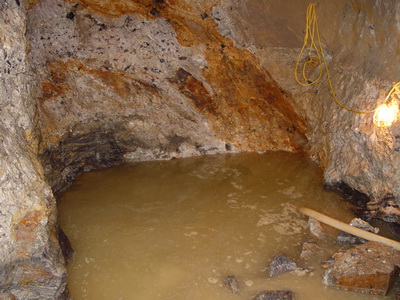 |
|
View of that advance made to the east of the big pocket of '05. Schist can be seen both on the left and right sides of the cut just at the water level.
|
well to each other and have been extensively cracked over the eons. The injection of the pegmatite forming melt has also reduced their integrity and altered the schist to a spongy consistency. Adding to the complexity of the situation, water trickles continually through the cracks. As it does so it brings in small particles of clay. Massive plates can be bound to the ceiling by nothing more than suction. Given all of this they occasionally dislodge themselves from the ceiling. So after each blast carefully checking
and scaling of the roof is essential.
Our latest worked confirmed, or so we thought at the time, that mining to the south beyond the big space was not going to prove to be productive. As peg dipped to the SE, we decided to turn our advance in that direction. This course change would require us to mine directly through our xenolith discussed above. As it was huge, it was an open question really whether it was a 'horse' or just the end of the road. So early in September we commenced to excavate this mass.
The first interesting event was we intercepted one of the failed vent holes that were drilled down from the surface in 2006. Failed in the sense that it did not go into our workings. In '06 in preparation for this expensive project I had carefully triangulated the spot on the surface 60 feet above where I felt the vent shafts should be drilled in order to intercept our workings below. Next the loose soil was removed so that the well driller would start his work on rock and not soil... we were paying by the foot. We employed a well driller as
they could drive the largest diameter hole at the lowest cost. However, the driller was unhappy about the hole that we had dug so we had to 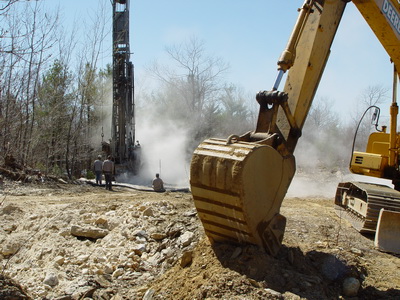 move the location...slightly. We had two choices....left or right. I guessed wrong and went left 3 feet. The 8" hole just missed our workings. As the drilling progressed I went underground and I could feel intense vibrations in the wall.
Then it occurred to me that this is really dumb.... to be standing 60' underground waiting for a down hole hammer to breach into the workings. As drilling proceeds very high pressure air is used to blow the cuttings out of the hole. At any moment the wall could fail and I'd get the blast in the face. No, not smart at all. Two more bad guesses followed. The 2nd guess eventually became our electrical and communications conduit to the
surface. Finally, and very expensively.. we were paying by the foot as mentioned above.. the 4th attempt dropped into the advance below. This hole was followed by 3 more forming our main air way into the mine. So it was rather exciting locating our first expensive miss. The hole now had a standing column of water 65' feet by 8" in diameter high. As our drill plunked into it...exactly the way it would do if we drilled into a pocket...it was immediately followed by a high pressure jet of water
as the hole drained....scenes from a 'Laurel and Hardy' movie with the water soaking all. For a brief moment we thought we had drilled a space but this happy notion soon drained away too. move the location...slightly. We had two choices....left or right. I guessed wrong and went left 3 feet. The 8" hole just missed our workings. As the drilling progressed I went underground and I could feel intense vibrations in the wall.
Then it occurred to me that this is really dumb.... to be standing 60' underground waiting for a down hole hammer to breach into the workings. As drilling proceeds very high pressure air is used to blow the cuttings out of the hole. At any moment the wall could fail and I'd get the blast in the face. No, not smart at all. Two more bad guesses followed. The 2nd guess eventually became our electrical and communications conduit to the
surface. Finally, and very expensively.. we were paying by the foot as mentioned above.. the 4th attempt dropped into the advance below. This hole was followed by 3 more forming our main air way into the mine. So it was rather exciting locating our first expensive miss. The hole now had a standing column of water 65' feet by 8" in diameter high. As our drill plunked into it...exactly the way it would do if we drilled into a pocket...it was immediately followed by a high pressure jet of water
as the hole drained....scenes from a 'Laurel and Hardy' movie with the water soaking all. For a brief moment we thought we had drilled a space but this happy notion soon drained away too.
The bulk of this early mining was focused on driving an advance to the south east. It would essentially be directly through our xenolith (contact?) mentioned above. If it were indeed a xenolith we should breach through to the other side eventually. Our first 10' advance showed no let up in this body. The 2nd was much the same. The miners, an emotional and superstitious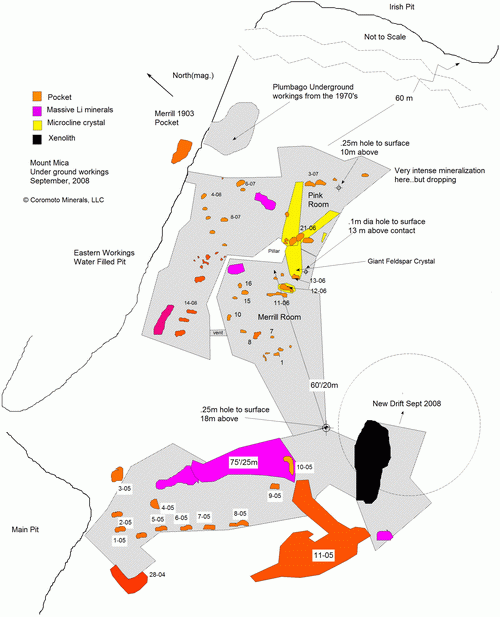 lot, were beginning to loose heart... without of course saying so. We did have some intelligence ( information not IQ) backing us up. In 2005 we had purchased a day's worth of percussion drilling to maximum depth of 70'. The idea was we'd attempt measure the extent of the pegmatite across the likely range of our underground mining effort. This method is a poor man's core drilling. As the drill descends the cuttings are observed and collected.
The interface between the country rock (schist) and pegmatite is obvious. The drill cuttings go from gray to white. The penetration rate of the drill is slowed within the pegmatite and samples taken. These are washed and carefully examined. One can get a rough idea of the mineralogy. The thickness of the pegmatite is also noted and it's burial depth. One of the spots we sampled was just to the southeast of our present position. So we knew there was pegmatite ahead. As fate would have, the track drill
suffered a major breakdown on this very hole. The hole was eventually completed indicating there was pegmatite quite deep down, about 65' feet. This was some 10' lower than our present drift location. We'd come to understand why much later. The drill operator was half hearted in this effort as he was of the opinion that those 'rock hounds' needed to get life. {At 70' below ground and roughly 1200' of drift behind us, I like to think of ourselves as miners and not 'one of those rock hounds'. In CFR30
Part 57 ( Code of Federal Regulations Minerals Resources Underground Mine Metal and non-Metal) there is not a single reference to rock hounding. Pleading rock hounding to MSHA bears no truck. We are required to march to Part 57's drum} So our less than committed driller by means of push buttons could drill to 60'. Beyond that an extension rod had to be inserted manually on to the drill string. At this point in the process he enthusiasm would drop to negative numbers. Gentle encouragement was
required. lot, were beginning to loose heart... without of course saying so. We did have some intelligence ( information not IQ) backing us up. In 2005 we had purchased a day's worth of percussion drilling to maximum depth of 70'. The idea was we'd attempt measure the extent of the pegmatite across the likely range of our underground mining effort. This method is a poor man's core drilling. As the drill descends the cuttings are observed and collected.
The interface between the country rock (schist) and pegmatite is obvious. The drill cuttings go from gray to white. The penetration rate of the drill is slowed within the pegmatite and samples taken. These are washed and carefully examined. One can get a rough idea of the mineralogy. The thickness of the pegmatite is also noted and it's burial depth. One of the spots we sampled was just to the southeast of our present position. So we knew there was pegmatite ahead. As fate would have, the track drill
suffered a major breakdown on this very hole. The hole was eventually completed indicating there was pegmatite quite deep down, about 65' feet. This was some 10' lower than our present drift location. We'd come to understand why much later. The drill operator was half hearted in this effort as he was of the opinion that those 'rock hounds' needed to get life. {At 70' below ground and roughly 1200' of drift behind us, I like to think of ourselves as miners and not 'one of those rock hounds'. In CFR30
Part 57 ( Code of Federal Regulations Minerals Resources Underground Mine Metal and non-Metal) there is not a single reference to rock hounding. Pleading rock hounding to MSHA bears no truck. We are required to march to Part 57's drum} So our less than committed driller by means of push buttons could drill to 60'. Beyond that an extension rod had to be inserted manually on to the drill string. At this point in the process he enthusiasm would drop to negative numbers. Gentle encouragement was
required.
Hence, armed with this glimmer of insight, we pressed on despite the 'bad signs'. Finally we had reached the denouement of this latest underground sub-drama. The schist was showing signs of ending. As Brian started to drill the hole I felt would be telling, I turned him and said, 'Brian, this will be one of the most important holes drilled at Mount Mica'. A quizzical look came back. If the drill cuttings started coming out the color of used motor oil and then started
to turn white, we were back into pegmatite. If they stayed dirty brown, the country rock was still in charge. As it turned out the transition occurred. We were now even more convinced that the schist was a xenolith.
Once we had clearly breached the xenolith the next big issue would be the quality of the pegmatite. As it turned out we started to see cleavelandite almost immediately. Cleavelandite, a platy albite, is in the sodium end of the plagioclase feldspar series. At Mount Mica almost all pockets are associated with platy albite. The 'cleave' was quite coarse forming small vugs amongst the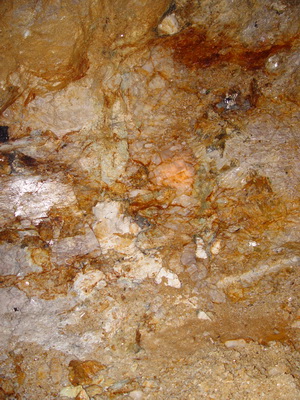 blades. Occasionally one of these vugs would house a small green tourmaline. We were encouraged. As a side note, before we bought Mount Mica it was common knowledge it was 'mined out'. We were unaware of this key point and, in fact, we had never visited Mount Mica and only had a vague notion where it was. As it turned out, our notion was off by a mile or so. Hence the purchase was made in blissful ignorance. The same guiding hand of pure ignorance
had led to success at the Orchard Quarry. In addition, and to add to the drama, over the ensuing years of mining since the purchase, we had been privy to a range of opinions as to the what would happen as we mined underground further to the southeast. In a nutshell most if not all of these inputs were variants of the 'mined out' scenario. Our political action officer (me) was constantly on guard that the fragile morale of the miners not be undermined by these subversive 'centers'. If
you are not familiar with the concept of 'centers', read a little about the Stalin purges of the 1930s and the Moscow show trials. "Trotskyite-Zinovievite Terrorist Center", the Engineer's Center (also known as wreckers of the various 5 year plans), the Doctor's Center etc. In Stalin's case he could enlist the services of the NKVD . I could only dream of such. So it now seemed that The Mined Out Center needed to refine their predictions for it was clear as we advanced SE that a pocket of some kind was in the offing. Whew! blades. Occasionally one of these vugs would house a small green tourmaline. We were encouraged. As a side note, before we bought Mount Mica it was common knowledge it was 'mined out'. We were unaware of this key point and, in fact, we had never visited Mount Mica and only had a vague notion where it was. As it turned out, our notion was off by a mile or so. Hence the purchase was made in blissful ignorance. The same guiding hand of pure ignorance
had led to success at the Orchard Quarry. In addition, and to add to the drama, over the ensuing years of mining since the purchase, we had been privy to a range of opinions as to the what would happen as we mined underground further to the southeast. In a nutshell most if not all of these inputs were variants of the 'mined out' scenario. Our political action officer (me) was constantly on guard that the fragile morale of the miners not be undermined by these subversive 'centers'. If
you are not familiar with the concept of 'centers', read a little about the Stalin purges of the 1930s and the Moscow show trials. "Trotskyite-Zinovievite Terrorist Center", the Engineer's Center (also known as wreckers of the various 5 year plans), the Doctor's Center etc. In Stalin's case he could enlist the services of the NKVD . I could only dream of such. So it now seemed that The Mined Out Center needed to refine their predictions for it was clear as we advanced SE that a pocket of some kind was in the offing. Whew!
So it was additional relief  when on September 3rd we began to see the emergence of lithia minerals in the form of lepidolite and spodumene. On the next advance a large mass of quartz appeared. In the photo on the right a variety of lithium bearing minerals can be seen...lepidolite, montebrasite, spodumene. The fabric of the pegmatite
had undergone a rapid transition from fine grain to a complex coarse grain. At Mount Mica large masses of milky gray quartz are associated only with pockets. One of the 2000+ never fail pocket signs. As it turned out this mass formed the cap of a large pocket. In the image to the left the pocket is just emerging under the blade of the hoe. What we did not appreciate at the time and would only when on September 3rd we began to see the emergence of lithia minerals in the form of lepidolite and spodumene. On the next advance a large mass of quartz appeared. In the photo on the right a variety of lithium bearing minerals can be seen...lepidolite, montebrasite, spodumene. The fabric of the pegmatite
had undergone a rapid transition from fine grain to a complex coarse grain. At Mount Mica large masses of milky gray quartz are associated only with pockets. One of the 2000+ never fail pocket signs. As it turned out this mass formed the cap of a large pocket. In the image to the left the pocket is just emerging under the blade of the hoe. What we did not appreciate at the time and would only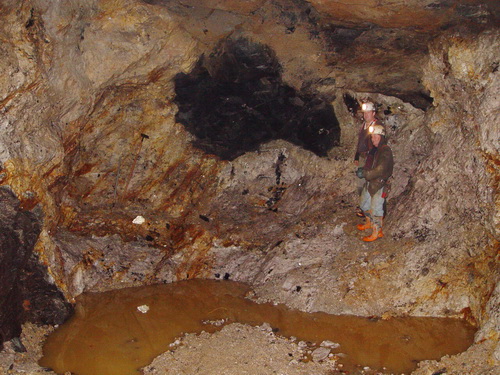 come to fully appreciate more than a year how high up on the side of a plunge we were working. The pocket we had just found, officially MMP20-08 (other pocket of 2008), was dubbed the Buffalo pocket by Richard and Brian. A large mass of schist in the ceiling did resemble some Neolithic cave painting of a buffalo. This 'cave' though was but days old though 300 million years in the making. come to fully appreciate more than a year how high up on the side of a plunge we were working. The pocket we had just found, officially MMP20-08 (other pocket of 2008), was dubbed the Buffalo pocket by Richard and Brian. A large mass of schist in the ceiling did resemble some Neolithic cave painting of a buffalo. This 'cave' though was but days old though 300 million years in the making.
We had high hopes for this latest pocket. We could see several very large schorls had penetrated the space. If they remained, escaping alteration, there could be large elbaites inside. This is what occurred in pocket MMP28-04. However it was not repated as almost all of the tourmaline had been completely altered to clays. There was ample evidence of their once existence. Whether their life was days or millions of years is not known. My guess is their time was fleeting as conditions within the space shifted away from those
favorable for tourmaline during the formative stages. The space was large though. As we opened it more we could see large manganese stained quartz crystals heaped inside.
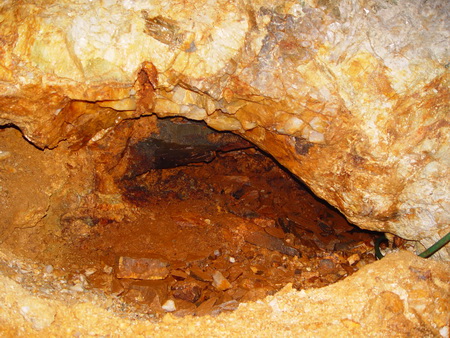 |
 |
|
The opening into MMP20-08, aka the Buffalo pocket
|
Mounds of manganese stained quartz crystals piled up inside
|
Over the next several days we removed many of these fallen quartz crystals expanding the interior dimensions of the chamber significantly. Most of these crystals had originally been attached to roof of the pocket. In addition to the main chamber itself there were several other chambers radiating from the main one. As we continued to excavate we could eventually crawl completely inside. This is a risky maneuver for if a small slab fell from the roof onto the
'diggers' back one might be in a 'tight' situation indeed. Frequently such concerns are pushed into the background as the quest proceeds. So with that I worked my way to the back 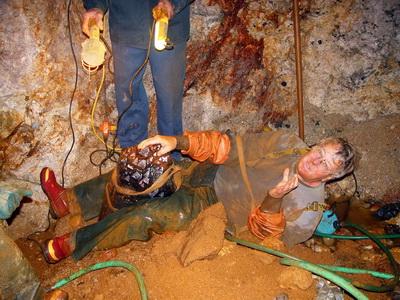 of chamber 2 I could see a huge quartz crystal with parallel overgrowth standing point down on the heap. When I checked how stabile the crystal was it began to lean. This meant it
was free but that the point of the crystal was grinding on whatever it was sitting on. I was certain it was not silk cushions. I could also see it was a nice crystal and would be worth the effort to extract it without additional damage. No doubt some had occurred over the millions of years since it developed. Unfortunately the space was just high enough to navigate on one's elbows. There was no way I was going to remove the crystal laying on my stomach. The only viable option I could see was to get out and go
back in feet first and clamp the crystal in my legs. We also decided to attach lines to the crystal so that Brian and Richard could pull from the outside of the pocket. However the first order of business of chamber 2 I could see a huge quartz crystal with parallel overgrowth standing point down on the heap. When I checked how stabile the crystal was it began to lean. This meant it
was free but that the point of the crystal was grinding on whatever it was sitting on. I was certain it was not silk cushions. I could also see it was a nice crystal and would be worth the effort to extract it without additional damage. No doubt some had occurred over the millions of years since it developed. Unfortunately the space was just high enough to navigate on one's elbows. There was no way I was going to remove the crystal laying on my stomach. The only viable option I could see was to get out and go
back in feet first and clamp the crystal in my legs. We also decided to attach lines to the crystal so that Brian and Richard could pull from the outside of the pocket. However the first order of business  was to turn the piece around so the point was up. In this way the dragging would be done on the broken end. When this maneuver was finally achieved I could see the points
were even more complex than I had imagined. So as they pulled I lifted the crystal off of the pocket floor with my legs and steered it along inch by inch. After about an hour of this effort the crystal was out. Taking only a brief look to check for damage, we wrapped in padding and loaded it into the skid steer to take it to the surface. In the image above I have just shimmied out of the pocket. Frank Perham's holds lights to illuminate the find. In the image to the left Brian poses
with the crystal through the fog as Frank looks on. No doubt Frank is thinking it could have been a little bit bigger and little bit gemmier. In fact, at that point, we knew little about what lay under all the black manganese and rust. was to turn the piece around so the point was up. In this way the dragging would be done on the broken end. When this maneuver was finally achieved I could see the points
were even more complex than I had imagined. So as they pulled I lifted the crystal off of the pocket floor with my legs and steered it along inch by inch. After about an hour of this effort the crystal was out. Taking only a brief look to check for damage, we wrapped in padding and loaded it into the skid steer to take it to the surface. In the image above I have just shimmied out of the pocket. Frank Perham's holds lights to illuminate the find. In the image to the left Brian poses
with the crystal through the fog as Frank looks on. No doubt Frank is thinking it could have been a little bit bigger and little bit gemmier. In fact, at that point, we knew little about what lay under all the black manganese and rust.
We worked the pocket finding no tourmaline other than a few remnant fragments though ample evidence of their existence as epimorphs (casts) of tourmaline in cookeite or any other significant mineral for that matter. We were always on the look out for beryl for often there were at least a few etched pieces. There was in fact beryl in this pocket. A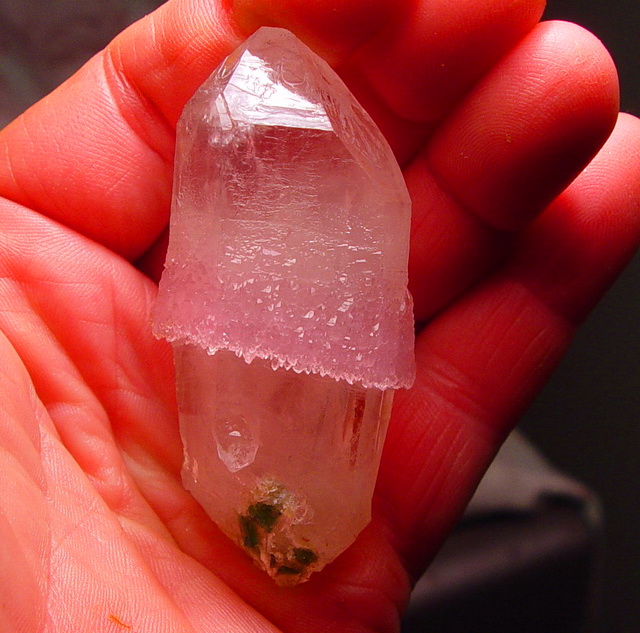 nice gem piece slipped through our hands pocket side, through our secondary screening operation and on to the neck of a lady in the form of a 55 carat morganite pendant. Oh well. However, tp brighten the picture somewhat, Brian and Richard began noticing signs of crystallized pink quartz in the form of tell tale rings. At Mt Mica this pink quartz often manifests itself in this way...almost like pox or psoriasis... on the sides of quartz crystals. Once we saw these signs
our hopes were that the huge quartz crystal we so laboriously extracted might be so infected. It would sometime though before we had means to de-rust such a large crystal. We did clean a number of smaller specimens and were pleased with the results. At the right a rather ordinary quartz crystal wears a pink tutu making it decidedly not cut of common cloth. nice gem piece slipped through our hands pocket side, through our secondary screening operation and on to the neck of a lady in the form of a 55 carat morganite pendant. Oh well. However, tp brighten the picture somewhat, Brian and Richard began noticing signs of crystallized pink quartz in the form of tell tale rings. At Mt Mica this pink quartz often manifests itself in this way...almost like pox or psoriasis... on the sides of quartz crystals. Once we saw these signs
our hopes were that the huge quartz crystal we so laboriously extracted might be so infected. It would sometime though before we had means to de-rust such a large crystal. We did clean a number of smaller specimens and were pleased with the results. At the right a rather ordinary quartz crystal wears a pink tutu making it decidedly not cut of common cloth.
So, to conclude this episode, we did indeed confirm that the Mined Out Center was wrong to this point at least (Author's note: It is September 2011. The MOC continues to hold out hope. We are now entering another area fraught with question marks. Such tensions keep the game interesting.) More to follow...
|
